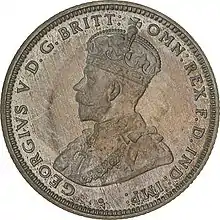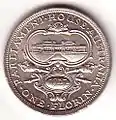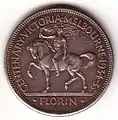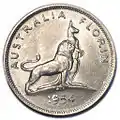Coins of the Australian pound
Pre-decimal Australian coins arose when the Federation of Australia gave the constitutional power to Commonwealth of Australia to mint its own coinage in 1901. The new power allowed the Commonwealth to issue legal tender rather than individually through the six former British self-governing colonies of Queensland, New South Wales, Victoria, Tasmania, South Australia, and Western Australia.


However, with the adoption of a Federal government in Australia, British coins continued to be used until 1910 when the first Australian silver coins were introduced. These new coins, which included florins, shillings, sixpences and threepences, were all minted with a portrait of Edward VII. A year later Australian pennies and half-pennies entered circulation. Unlike in New Zealand, there was no half-crown. In 1931 gold sovereigns stopped being minted in Australia. A crown or five-shilling coin was minted in 1937 and 1938.
Coinage of the Australian pound was replaced by decimalised coins of the Australian dollar on 14 February 1966. The conversion rate was A$2 = A£1.
Australian £sd
In 1898 the British government allowed two colonies, New South Wales and Victoria, to mint silver and bronze coins at their mints in Sydney and Melbourne respectively.
Coins
| Image | Value | Technical parameters | Description | Date of | Dated years of issue | ||||||
|---|---|---|---|---|---|---|---|---|---|---|---|
| Obverse | Reverse | Diameter | Mass | Composition | Obverse | Reverse | Edge | First issue | Withdrawal | ||
 |
 |
Half penny (½d) | 25.5 mm | 5.67 g | Bronze (97% copper, 2.5% zinc, 0.5% tin) | Portrait of King George V. Designed by Sir E. B. Mackennal. | At centre within a circle of beads, the denomination "ONE HALF PENNY" in three lines above a plain scroll; around the circle of beads, "COMMONWEALTH OF AUSTRALIA" and date. Designed by W. H. Blackmore. | Plain | 1911 | 14 February 1966 | 1911–1936 |
 |
Portrait of King George VI. Designed by Thomas H. Paget. | 1938 | 1938–1939 | ||||||||
 |
Kangaroo facing right, "AUSTRALIA" above and "HALF PENNY" below, date above denomination. Designed by George Kruger Gray. | 1939 | 1939–1952 | ||||||||
 |
Portrait of Queen Elizabeth II. Designed by Mrs Mary Gillick. | 1953 | 1953–1955, 1959–1964 | ||||||||
 |
 |
Penny (1d) | 30.8 mm | 9.45 g | Portrait of King George V. Designed by Sir E. B. Mackennal. | At centre within a circle of beads, the denomination "ONE PENNY" in three lines above a plain scroll; around the circle of beads, "COMMONWEALTH OF AUSTRALIA" and date. Designed by W. H. Blackmore. | 1911 | 1911–1936 | |||
 |
 |
Portrait of King George VI. Designed by Thomas H. Paget. | Kangaroo facing left, "AUSTRALIA" above and "PENNY" below, date above denomination. Designed by George Kruger Gray. | 1938 | 1938–1952 | ||||||
 |
Portrait of Queen Elizabeth II. Designed by Mrs Mary Gillick. | 1953 | 1953, 1955–1964 | ||||||||
 |
 |
Threepence (3d) | 16 mm | 1.41 g | Sterling silver (92.5% silver, 7.5% copper) | Portrait of King Edward VII. Designed by George W. De Saulles. | At centre, 1908 Australian coat of arms. Motto in the ribbon "ADVANCE AUSTRALIA", "THREEPENCE" above and date between arrow heads below. Designed by W. H. Blackmore. | 1910 | 1910 | ||
 |
Portrait of King George V. Designed by Sir E. B. Mackennal. | 1911 | 1911–1912. 1914–1928, 1934–1936 | ||||||||
 |
 |
Portrait of King George VI. Designed by Thomas H. Paget. | Three ears of wheat held by a curved ribbon, AUSTRALIA", below divided into two by the stalks of the wheat "THREE PENCE", above, across the middle of the coin the date divided into two by the ears. Designed by George Kruger Gray. | 1938 | 1938–1944 | ||||||
| 50% silver, 40% copper, 5% zinc, 5% nickel | 1947 | 1947–1952 | |||||||||
 |
Portrait of Queen Elizabeth II. Designed by Mrs Mary Gillick. | 1953 | 1953–1964 | ||||||||
 |
 |
Sixpence (6d) | 19 mm | 2.83 g | Sterling silver (92.5% silver, 7.5% copper) | Portrait of King Edward VII. Designed by George W. De Saulles. | At centre, 1908 Australian coat of arms. Motto in the ribbon "ADVANCE AUSTRALIA", "SIXPENCE" above and date under the crest below. Designed by W. H. Blackmore. | Redded | 1910 | 1910 | |
 |
Portrait of King George V. Designed by Sir E. B. Mackennal. | 1911 | 1911–1912, 1914, 1916–1928, 1934–1936 | ||||||||
 |
Portrait of King George VI. Designed by Thomas H. Paget. | 1938 | 1938–1945 | ||||||||
| 50% silver, 40% copper, 5% zinc, 5% nickel | 1946 | 1946, 1948, 1950–1952 | |||||||||
 |
Portrait of Queen Elizabeth II. Designed by Mrs Mary Gillick. | 1953 | 1953–1963 | ||||||||
 |
 |
Shilling (1/-) | 23.5 mm | 5.65 g | Sterling silver (92.5% silver, 7.5% copper) | Portrait of King Edward VII. Designed by George W. De Saulles. | At centre, 1908 Australian coat of arms. Motto in the ribbon "ADVANCE AUSTRALIA", "ONE SHILLING" above and date under the crest below. Designed by W. H. Blackmore. | 1910 | 1910 | ||
 |
Portrait of King George V. Designed by Sir E. B. Mackennal. | 1911 | 1911–1922, 1924–1928, 1931, 1933–1936 | ||||||||
 |
 |
Portrait of King George VI. Designed by Thomas H. Paget. | Ram's head facing left, "AUSTRALIA" above, two Federation stars, "SHILLING" and year below. Designed by George Kruger Gray. | 1938 | 1938–1944 | ||||||
| 50% silver, 40% copper, 5% zinc, 5% nickel | 1946 | 1946, 1948, 1950, 1952 | |||||||||
 |
Portrait of Queen Elizabeth II. Designed by Mrs Mary Gillick. | 1953 | 1953–1963 | ||||||||
 |
 |
Florin (2/-) | 28.5 mm | 11.31 g | Sterling silver (92.5% silver, 7.5% copper) | Portrait of King Edward VII. Designed by George W. De Saulles. | At centre, 1908 Australian coat of arms. Motto in the ribbon "ADVANCE AUSTRALIA", "ONE FLORIN – TWO SHILLINGS" above and date under the crest below. Designed by W. H. Blackmore. | 1910 | 1910 | ||
 |
Portrait of King George V. Designed by Sir E. B. Mackennal. | 1911 | 1911–1928, 1931–1936 | ||||||||
 |
 |
Portrait of King George V. Designed by Sir E. B. Mackennal. | Old Parliament House within an oval frame set above crossed scepters. Superimposed on the scepters is a raised oval with the date 1927 incuse, "PARLIAMENT HOUSE AUSTRALIA" above, ONE FLORIN below. Designed by George Kruger Gray. | 1927 | 1927 | ||||||
 |
 |
Portrait of King George V. Designed by Percy Metcalf. | Naked rider advancing to the left holding a flaming torch aloft; in exergue, "FLORIN", "CENTENARY . VICTORIA . MELBOURNE . 1934–35." above. Designed by George Kruger Gray. | 1934/35 | 1934/35 | ||||||
 |
 |
Portrait of King George VI. Designed by Thomas H. Paget. | Based on the arms of the Commonwealth of Australia, as authorised by Royal Warrant 19 September 1912. "FLORIN" above between two seven pointed stars. below, in the exergue the date, "AUSTRALIA" below. Designed by George Kruger Gray. | 1938 | 1938–1945 | ||||||
| 50% silver, 40% copper, 5% zinc, 5% nickel | 1946 | 1946–1947, 1951–1952 | |||||||||
 |
A scepter and sword crossing below a crown and above the Federation Star with the stars of the Southern Cross around, "AUSTRALIA" above, "FLORIN" below and split into two parts by a star, to left "1901" and to right "1951". Designed by William Leslie Bowles. | 1951 | 1951 | ||||||||
 |
Portrait of Queen Elizabeth II. Designed by Mrs Mary Gillick. | Based on the arms of the Commonwealth of Australia, as authorised by Royal Warrant 19 September 1912. "FLORIN" above between two seven pointed stars. below, in the exergue the date, "AUSTRALIA" below. Designed by George Kruger Gray. | 1953 | 1953–1954, 1956–1963 | |||||||
 |
A lion and a kangaroo standing together on a curved ground line facing right, "AUSTRALIA FLORIN" above, below in exergue, "1954". Designed by William Leslie Bowles. | 1954 | 1954 | ||||||||
 |
 |
Crown (5/-) | 38.5 mm | 28.27 g | Sterling silver (92.5% silver, 7.5% copper) | Portrait of King George VI. Designed by Thomas H. Paget. | At centre the Imperial crown with the date below, "COMMONWEALTH OF AUSTRALIA" above, "ONE CROWN" below. Designed by George Kruger Gray. | 1937 | 1937–1938 | ||
Pre-decimal commemorative coins
Florin = 2 shillings
 1927 Australian florin commemorating the opening of the original Parliament House
1927 Australian florin commemorating the opening of the original Parliament House 1934-35 Australian florin commemorating the centenary of Victoria and the establishment of Melbourne
1934-35 Australian florin commemorating the centenary of Victoria and the establishment of Melbourne 1951 Australian florin commemorating 50 years of the Commonwealth of Australia
1951 Australian florin commemorating 50 years of the Commonwealth of Australia 1954 Australian florin struck to commemorate the visit to Australia of Queen Elizabeth II on 3 Feb 1954.
1954 Australian florin struck to commemorate the visit to Australia of Queen Elizabeth II on 3 Feb 1954.
 The obverse of the commemorative 1927 Australian florin, with
The obverse of the commemorative 1927 Australian florin, with
King George V The obverse of the commemorative 1934-35 Australian florin
The obverse of the commemorative 1934-35 Australian florin The obverse of the commemorative 1951 Australian florin, with
The obverse of the commemorative 1951 Australian florin, with
King George VI The obverse of the commemorative 1954 Australian florin, with Queen Elizabeth II
The obverse of the commemorative 1954 Australian florin, with Queen Elizabeth II
References
- "The 1930 penny". Triton Technologies. 14 July 2001. Archived from the original on 5 October 2018. Retrieved 20 January 2022.
- "Proof 1930 penny sold for $1.15 million". Coinworks. Retrieved 20 January 2022.
General references
- Ian W. Pitt, ed. (2000). Renniks Australian Coin and Banknote Values (19th ed.). Chippendale, N.S.W.: Renniks Publications. ISBN 0-9585574-4-6.
- Krause, Chester L.; Clifford Mishler (2003). 2004 Standard Catalog of World Coins: 1901–Present. Colin R. Bruce II (senior editor) (31st ed.). Krause Publications. ISBN 0873495934.